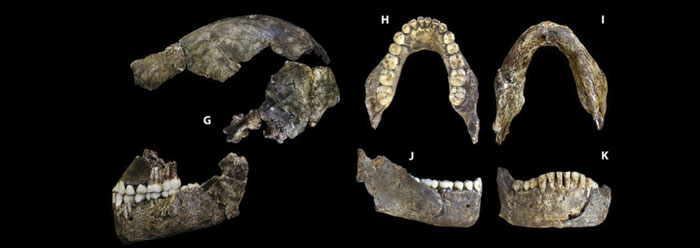In the December 2015 issue of Acts & Facts, we pointed out some strange circumstances surrounding the cave in which Homo naledi—one of the most recent hyped examples of a “human ancestor”—was discovered and addressed concerns over critical mismatches in body parts. But another problem casts even further doubt on the evolutionists’ claim that Homo naledi is a transitional creature between apes and humans: They haven’t used standard techniques to date the fossils.
The scientists assume the fossils are 2 to 2.5 million years old, fitting perfectly with their story of human evolution.1 However, no results of any sort of dating method for Homo naledi 1-3 have been published, and so this estimate is not based on any empirical information.1
Dating Methods
The researchers reported an attempt to date the fossils using the uranium-series dating technique, which measures the amount of uranium trapped in flowstone deposits and compares it to an assumed deposition rate.4,5 But they never revealed the results of this “failed” attempt because they claimed the process was contaminated from “fine dusting of a detrital component derived from associated muds.”3
It appears they also assumed the bones were too old to test for measurable amounts of carbon-14.6 Finding no carbon-14 in the bones would help their case by eliminating age assignments of less than 100,000 years. In contrast, detectable carbon-14 would demonstrate a youthful age—placing Homo naledi alongside species of modern humans.
The researchers could also have used electron spin resonance dating that other evolutionists use for tooth enamel.7 Homo naledi researcher Lee Berger’s team found 179 dental crowns in the cave—yet no test was conducted.3
Why wouldn’t a team of high-profile, cutting-edge scientists use every testing method at their disposal to help clarify exactly what these specimens are and what they truly represent?
Perhaps they’re doubtful about the results. If tests revealed an age of thousands of years, it would clearly expose these fossils as too young to represent an evolutionary transition—nullifying the discovery.
Scattered Bones
The mystery of how the bones ended up in the deep cave chamber won’t be easily resolved. Sedimentary evidence in the cave floor suggests periods of higher water flow rates.1 And the bones were broken and randomly dispersed in the upper eight inches of sediment.3
Berger and his team think the bones were deliberately placed by living Homo naledi in a burial ritual.3 He claimed, “Disposal of the dead brings closure for the living and confers respect. Such sentiments are a hallmark of humanity. But H. naledi was not human.”1 However, the long, convoluted path within the cave to ritually bury these remains makes this interpretation unlikely, and others disagree with Berger. Richard Leakey believes they probably washed in, stating, “There has to be another entrance.”1
The scattering of these bones within the upper few inches of sediment in the cave floor suggests recent emplacement. They could have washed in during periods of high water flow, perhaps during the Ice Age, when water levels and climate fluctuations were more dramatic and sporadic. The Bible indicates the Ice Age took place around 4,300 years ago.8
Conclusion
The geology, anatomy, lack of dating, and evidence of recent water action reveal that the media blitz and excitement over Homo naledi is essentially based on falsehood.
These fossils are most likely thousands of years old and deposited post-Flood. The claimed new species appears to be a mosaic of different species put together based on evolutionary biases, not scientific evidence. God did not make creatures that were “almost human,” and no evidence has refuted this—including Homo naledi.
References
- Shreeve, J. 2015. Mystery man: A trove of fossils found deep in a South African cave adds a baffling new branch to the human family tree. National Geographic. 228 (4): 30-57.
- Berger, L. R. et al. Homo naledi, a new species of the genus Homo from the Dinaledi Chamber, South Africa. eLife. Posted on elifesciences.org September 10, 2015, accessed September 15, 2015.
- Dirks, P. et al. Geological and taphonomic context for the hominin species Homo naledi from the Dinaledi Chamber, South Africa. eLife. Posted on elifesciences.org September 10, 2015, accessed September 15, 2015.
- Pickering, R. et al. 2007. Stratigraphy, U-Th chronology, and paleoenvironments at Gladysvale Cave: insights into the climatic control of South African hominin-bearing cave deposits. Journal of Human Evolution. 53 (5): 602-619.
- Pickering, R. et al. 2011. Contemporary flowstone development links early hominin bearing cave deposits in South Africa. Earth and Planetary Sciences Letters. 306 (1): 23-32.
- Bascomb, B. Archaeology’s Disputed Genius. Nova Next. Posted on pbs.org September 10, 2015, accessed October 4, 2015.
- Grün, R. 1989. Electron spin resonance (ESR) dating. Quaternary International. 1: 65-109.
- Hebert, J. 2013. Was There an Ice Age? Acts & Facts. 42 (12): 20.
Image credit: Holotype specimen of Homo naledi, Dinaledi Hominin 1 (DH1). Copyright © 2015, Berger et al. eLife 2015, 4: e09560. Adapted for use in accordance with federal copyright (fair use doctrine) law. Usage by ICR does not imply endorsement of copyright holder.
* Dr. Clarey is Research Associate at the Institute for Creation Research and received his Ph.D. in geology from Western Michigan University.


















